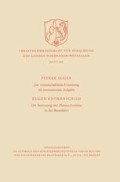Zusammenfassung
Bevor auf die Probleme des Plasma-Antriebes eingegangen werden kann, muß die Frage beantwortet sein: Was versteht man unter „Plasma-Antrieb“?
Access this chapter
Tax calculation will be finalised at checkout
Purchases are for personal use only
Preview
Unable to display preview. Download preview PDF.
Schrifttum
P. Schöck, G. Krülle: Physikalische und technische Probleme des Lichtbogenstrahltriebwerkes. III. Europäischer Raumfahrt-Kongreß, Stuttgart, No. 1531 (63)
W. Finkelnburg, H. Maecker: Elektrische Lichtbögen und thermische Plasmen. Handbuch der Physik, Bd. 22
H. O. Noeske, R. Kassner: Analytical investigation of a bipropellant arc jet. ARS-Preprint 2125–61
G. Wood, A. Carter: Considerations in the design of a steady DC Plasma Accelerator; Dynamics of Conducting Gases. Northwestern Univ. Press, 1960
G. Wood, et al: A theoretical Treatment of the steady-flow linear, crossed-field, DC Plasma Accelerator for inviscid, adiabatic isothermal, constant-area flow. NASA-Technical Report R —114
G. Seikel: Generation of thrust-electromagnetic Thrustors. Proceedings of the NASA-University, Conference on the Science and Technology of Space Exploration, Vol. 2, Chicago/Ill., Nov. 1962
A. Kunen, W. Mcllroy: The electromagnetic Pinch Effect for Space Propulsion; Dynamics of conducting Gases. Nortwestern Univ. Press, 1960
H. Wichmann: Elektrische Antriebe für Raumfahrzeuge. ETZ-A (1963), Heft 8, S. 245–52; auch DVL-Bericht Nr. 296
G. Paner: Untersuchungen an einer elektrodenlosen MHD-Triebwerksanlage. Jahrbuch Wissenschaftliche Gesellschaft für Luft- und Raumfahrt, 1962
W. Bieger, H. Gresser, P. Noll, H. Tuczeck: Beschleunigung von Plasma mit einer elektrodenlosen konischen Ringentladung. Bericht der KfA Jülich, 79 P. P.
Author information
Authors and Affiliations
Rights and permissions
Copyright information
© 1964 Springer Fachmedien Wiesbaden
About this chapter
Cite this chapter
Knoernschild, E.M. (1964). Die Bedeutung der Plasma-Antriebe in der Raumfahrt. In: Die wissenschaftliche Forschung als internationale Aufgabe. Die Bedeutung der Plasma-Antriebe in der Raumfahrt. Arbeitsgemeinschaft für Forschung des Landes Nordrhein-Westfalen, vol 139. VS Verlag für Sozialwissenschaften, Wiesbaden. https://doi.org/10.1007/978-3-663-02281-7_2
Download citation
DOI: https://doi.org/10.1007/978-3-663-02281-7_2
Publisher Name: VS Verlag für Sozialwissenschaften, Wiesbaden
Print ISBN: 978-3-663-00368-7
Online ISBN: 978-3-663-02281-7
eBook Packages: Springer Book Archive

